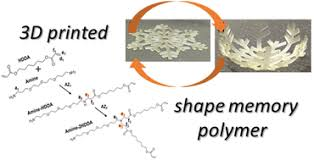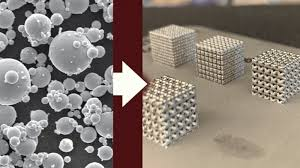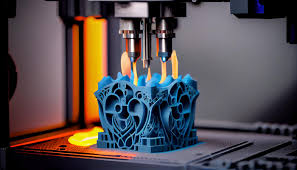Metal 3D printing technology is based on computer three-dimensional design through layered discrete components and CNC molding systems, using laser sintering molding process, laser cladding molding process, or plasma rapid deposition process to produce three-dimensional metal entities. The 3D printer is divided into several layers according to the three-dimensional CAD model. Materials such as 3D printing metal atomization ball powder or Ni-Ti alloy wire for special high-end 3D printing are sintered or bonded together. Then, the layers are superimposed and through different circle shapes. The layers are accumulated layer by layer and finally printed into a three-dimensional solid body.

3D printing shape memory alloy materials and preparation quality requirements
Shape memory alloy materials can remember their original shape after being deformed at low temperatures. This phenomenon is called alloy-shape memory. The shape memory alloy undergoes a structural transformation during the process of transforming from a stable high-temperature austenite state to a stable low-temperature martensite. The phase transformation temperature is ‒20~80 ℃, and the deformation temperature is 0~5 ℃. The composition can slightly change. and heat treatment to adjust. Among them, Ti-56Ni, Ti-31Ni, Ti54-57Ni and other alloys are widely used in the medical field. For example, the application of biomedical surgical implants—artificial bone joints, skulls, skulls, sternums, ribs, hip bones, patellar claws, circumferential bone plates, hip internal pins, dental bones, vascular stents and other biomaterials.
Medical devices and surgical implants have strict requirements for 3D printing materials. Considering the physical properties and biocompatibility of the material's biomechanics, the main requirements that its performance must meet are:
1. National Standard GB24627-2009 Medical Devices and Surgical Implants Nickel-titanium shape memory alloy processing material.
2. Has excellent corrosion resistance.
3. Has excellent biocompatibility, adhesion, and bone fusion.
4. Has excellent mechanical properties, high strength, high stability, High fatigue strength, high tensile strength, and small elastic modulus.
In general, 3D printing porous surfaces can reduce the elastic modulus of materials; 5) It has good processing performance, environmental protection, non-toxicity, good deformability, fast, fast molding, strong applicability, low cost, and uniform chemical composition.
Due to the particular performance requirements of Ni-Ti shape memory atomized spherical powder and wire, its chemical composition (mass fraction) is designed to be: Ni, 54.5%~57.0%; Ti is sponge titanium of grade 0 or above; C, ≤ 0.05%; H, ≤0.050%; N, ≤0.050%; Co, ≤0.050%; Cu, ≤0.010%; Cr, ≤0.010%; Nb, ≤0.025%; Fe, ≤0.050%.

For nickel-titanium shape memory alloy atomized spherical powder and high-end Ni-Ti shape memory alloy wire, different vertical development fields have emerged based on the application directions of their 3D printing materials. For example, 3D printed vascular self-expanding stents are used as permanent implants in the cardiovascular system, implanted through a catheter and deployed based on shape memory; 3D printed Ni-Ti shape memory alloy materials are used to print skulls, skulls, plates, chest rib joints wait.
The key technology for preparing high-end Ni-Ti shape memory alloy wire for 3D printing by vacuum induction furnace smelting method is the ratio of nickel-titanium alloy elements. The control of impurity elements oxygen, nitrogen, hydrogen, and carbon is particularly important. A water-cooled copper crucible is used, and under the action of electromagnetic eddy current stirring, an ingot with less pollution and uniform chemical composition is obtained. The ingot is hot-rolled into a disc with a diameter of ϕ6~8 mm. The hot rolling temperature is 800~900 ℃ and the rotary forging temperature is 700~850 ℃. Intermediate annealing is performed every 10% of cold drawing. The annealing temperature is 700 ~850℃. Nickel-titanium shape memory alloy has good hot processing properties. It can be processed by forging, extrusion, hot rolling, swaging and drawing, etc., and various specifications of wire can be obtained. The specifications of high-end Ni-Ti shape memory alloy wire for 3D printing are ϕ1.0~3.5 mm. Using a plasma rapid deposition process 3D printer. The alloy wire is sent to a plasma nozzle cooled by an argon gas mask. The alloy wire is melted in an argon atmosphere. After layered printing through digital control, the skull cap, sternum, and bones can be printed. Ribs and other solid objects are then processed into solid finished products with a small amount of grinding.

The 3D printing Ni-Ti shape memory alloy atomized spherical powder was prepared by vacuum induction furnace melting method. A 50~500 kg vacuum induction furnace was used for melting, using the gas atomization method and water atomization method. Atomized spherical metal powder can be used in metal 3D printers using laser cladding molding processes and plasma rapid deposition processes. The quality standards of the prepared atomized spherical powder for 3D printing refer to the national standards of similar materials. At present, no national standard for the quality of shape memory alloy atomized spherical powder has been established. The particle size, shape and purity of the powder are mainly determined according to customer requirements. Particle size is generally divided into four levels: 50-1000 µm is coarse powder; 10-50 µm is fine powder; 0.5-10 µm is micro powder; <0.5 µm is ultra-fine powder. It is required that the chemical composition must be uniform, without chemical segregation, and have excellent physical properties.
Supplier
Kmpass is a high-tech enterprise committed to the research and development, production, processing, sales and technical services of 3D printing materials. The company develops a variety of powder materials and chemicals. Provide OEM service. If you need high quality 3D printing powder, please feel free to contact us.
hot tags: 3d printing,3d printing technology, 3d printer



